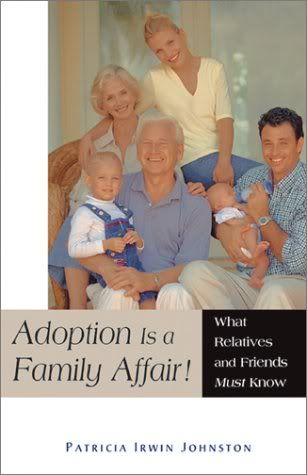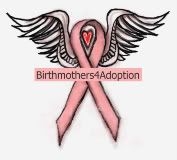Adoption is a Family Affair: What Relatives and Friends Must Know
by Patricia Irwin Johnston
My family has been very supportive of our efforts to adopt. They have expressed concerns at times, born sheerly out of love for us and lack of information, but they have always been hopeful for us. They have seen both to beautiful side of adoption, and the ugly side. They have encouraged us through the hard times.
That said, I think I will purchase a copy of this book and send it to them. I found it enlightening myself. It if full of resources to learn more about any adoption topic you can think of. At the end of every chapter is a list of books that deal with the chapter topic in greater depth. This book has dramatically increased my adoption reading list (as if it weren’t all ready way too long!)
For anyone who feels that they would like to better support their family or friends in their adoption journey, this is the book to read. For anyone who would like more support from their friends and family, this is the book to give them.
The book begins by helping family (it is particularly directed at the parents of potential adoptive parents) recognize and understand their own fears. From worrying that the child won’t fit into the family, to concerns over transracial adoption, and facing the unusual situation that is open adoption, this is where you start. Moving forward means coming to terms with your own fears. This first section will help your family do just that.
The next few chapters address the inherent pain that accompanies adoption. Because our family suffered through our hellish pregnancy with us, they also knew that all other children would join us through adoption. They grieved our strange form of infertility with us, so I had never considered what it must be like for a family to be faced with the sudden announcement that a child will join their family through adoption. They will not have had the same grieving period that the potential adoptive parents have had. They may not have even known that they were trying (and probably failed) to conceive. These chapters help family to understand why they may not feel the joy and excitement that their adopting family members would hope them to feel, and what to do about it. It also covers what to do and say if someone has all ready “blow it.”
The next chapter addresses the common myths that people may have about adoption and explains the adoption process, putting those myths to rest.
Other chapters explain how family members can help the potential adoptive parent or parents through every stage of the process. How to help them get ready, how to respect their privacy (what very little they have left) and how to celebrate their paper pregnancy. What to expect and how to help when the baby arrives. How the homecoming of an adopted baby is different than the homecoming of a biological baby and how to respect that.
One of the parts about the book that I liked the best is when the author talks about how family members and friends often think that because the new mother isn’t recovering from child birth that she doesn’t need the same kind of support. She revels that the emotional trial of adoption is just as fatiguing as child birth, and reminds family members that bringing a newborn home still entails a lack of sleep and some serious adjustments to life in general. She also talks about the need for the new adoptive parents to “circle the wagons” and be the ones holding the child nearly all of the time. This is to help facilitate initial bonding, as they have not had the benefit of a nine month pregnancy to bond with their baby. She suggests that taking care of the more day-to-day aspects of life for the couple (like cooking and laundry) is much more helpful to them then visiting to “hold the baby.” She also discusses the fact that may adoptive parents, both mother and fathers, still face the “baby blues” following adoption and that this is something family members should be aware of and support them through.
Following chapters go through what to expect if the child joining your family is not a baby, the issues they can have and how family can help them adjust. The author also discusses what adoption means for a child in each major life stage and what they will need from their extended family. One of the most important topics Johnston discusses is the need for privacy surrounding the child’s adoption story. She stresses that it is their story to share when they want and keep private when they want, and how family members can respect that.
Lastly, there is a chapter that deals with the rest of the world and adoption. How, to deal with obnoxious questions, how to advocate for adoption and how to educate people who are not yet enlightened about adoption.
This is a wonderful book to help family members and friends understand how they can best become part of the adoption experience and support the adoptive parents as well as the new addition to the family. Mom and Dad, be on the lookout for your very own copy!







No comments:
Post a Comment